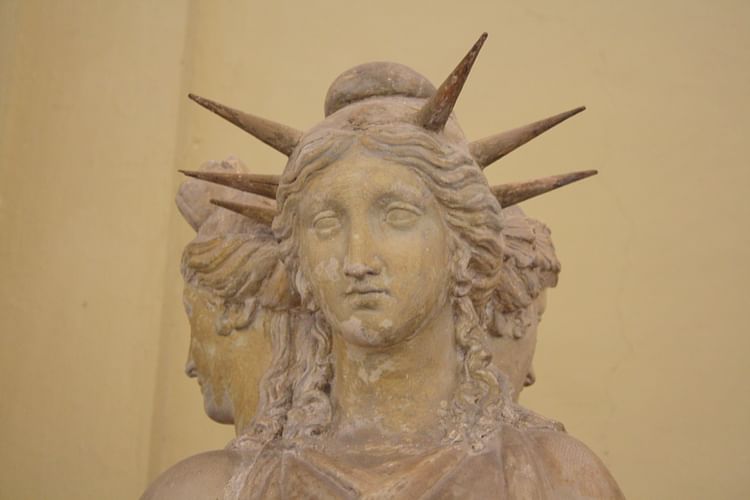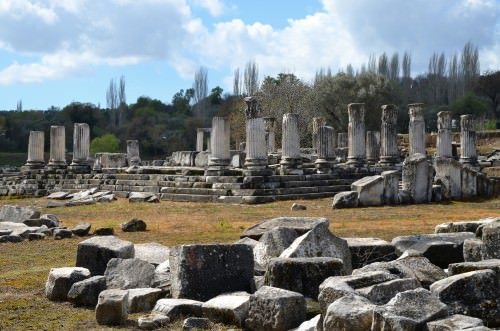Hecate › Mausoleum of Augustus » Origins and History
Articles and Definitions › Contents
- Hecate › Who Was
- Mausoleum of Augustus › Antique Origins
Ancient civilizations › Historical places, and their characters
Hecate › Who Was
Definition and Origins

Hecate (Hekate) is a goddess of Greek mythology who was capable of both good and evil. She was especially associated with witchcraft, magic, the Moon, doorways, and creatures of the night such as hell-hounds and ghosts. She is often depicted carrying a torch to remind of her connection with the night and in sculpture with three faces, representing her role as the guardian of crossroads.
GENEALOGY
According to Hesiod in his Theogony, Hecate is the daughter of Perses and Asteria, making her the granddaughter of the Titans Phoebe and Coeus. Euripides, on the other hand, mentions her mother is Leto. Other writers claim her as the daughter of Zeus and Demeter, Aristaion or Night. The goddess was frequently associated with Demeter and even assimilated to her in some cults.
ASSOCIATIONS & RITUALS
From the 5th century BCE, the goddess is associated with the darker side of the human experience, that is death, witchcraft, magic, the Moon, dreams, fierce hounds and creatures which roam the darkness of night. As the Oxford Classical Dictionary phrases it,
…outlandish in her infernal aspects, she is more at home on the fringes than in the centre of Greek polytheism.Intrinsically ambivalent and polymorphous, she straddles conventional boundaries and eludes definition. (649)
Hesiod describes the goddess in the following glowing terms:
Zeus, Cronus' son, honoured [Hecate] above all others: he gave her splendid gifts - to have a share of the earth and of the barren sea, and from the starry sky as well she has a share in honour, and is honoured most of all by the immortal gods. For even now, whenever any human on the earth seeks propitiation by performing fine sacrifices according to custom, he invokes Hecate; and much honor very easily stays with that man whose prayers the goddess accepts with gladness, and she bestows happiness upon him. (Theogony 411-420)
Hesiod goes on to say that the goddess supports warriors, athletes, hunters, horsemen, herdsmen, shepherds, fishermen, and children. Her companions are the Furies (Erinyes), the winged creatures who punished wrong-doing, and her children are the Empusae, female demons partial to seducing travellers.

The Temple of Hecate in Lagina, Caria
The goddess had unusual rituals performed in her honour, which include the offerings of food - given at crossroads, road junctions, and any other sort of boundary or threshold - known as 'the supper of Hecate'. These took the form of small cakes of eggs, cheese, bread, and dog meat, which were lit with miniature torches or, alternatively, a dish of red mullet, which was usually prohibited from offerings to the other gods. Hecate was also offered the sacrifice of dogs, especially puppies. The dog connection may be the fact that dogs were known to eat the dead if left unburied; they also howl at the moon, of course. A further canine connection may be with the Egyptian god Anubis who guided souls to the underworld, and the Greek three-headed hound of Hades, Cerberus, may be an earlier form of Hecate. The offerings to the goddess were made each month during the night of a new moon. The goddess was especially appealed to by sorceresses for aid in their magic and spells and appears on surviving examples of curse tablets.
IT WAS A COMMON PRACTICE TO PLACE IMAGES OF HECATE AT CITY GATES & THE DOORWAYS OF PRIVATE HOMES AS SHE COULD WARD OFF EVIL SPIRITS.
According to Pausanias, the 2nd-century CE Greek traveller, the island of Aegina had a mystery cult dedicated to the goddess where it was believed those suffering mental illness could be cured. Kos, Erythrai, Samothrace, Thessaly, and Miletos also worshipped the goddess, with the latter having a 6th-century BCE circular altar for sacrifices to be made in her honour (the earliest archaeological evidence of her worship). The worship of Hecate continued into the Hellenistic and Roman periods with significant archaeological finds of votive offerings to the goddess being found at Lagina in Caria and Phrygia.
HECATE IN ART
Hecate appears regularly in Greek art and literature only from the 5th century BCE onwards, before which she is only a minor figure who features in the stories of Demeter (as Persephone ’s handmaid) and Artemis. This may indicate the goddess' relatively late arrival in Greece from Caria, although, she was considered a Greek goddess and not of foreign origin by the ancient Greeks themselves. She is typically portrayed on Greek pottery as a young woman carrying a torch or a key, both reminders of her function as a night deity and a guardian of the gates of Hades. One 5th-century BCE Attic vase depicts a woman offering the goddess a puppy and a basket of cakes.

Hecate Fighting the Giant, Pergamon Altar
In sculpture, her most striking appearance occurs in Classical and Hellenistic Period figures which have the goddess with three bodies and three heads (or a single body with three heads or three bodies and a single head), usually with halos of moonbeams. The historian Robert Graves notes that the heads could be of a dog, lion, and horse, which represented the constellations which cover the calendar year. The goddess, though, usually appears with human heads. Known as hekataia, the first example of the triple-Hecate form is credited to a figure which guarded the entrance to the Acropolis of Athens, the Hekate Epipyrgidia ('On the Ramparts') by the 5th-century BCE sculptor Alcamenes. The 2nd-century BCE Pergamon Altar of Zeus has a three-headed Hecate attacking a snake-like giant, helped by a dog.
It was a common practice to place images of the goddess at city gates, entrances to sacred sites and the doorways of private homes where it was believed she acted as a protectress and warded off evil spirits. Finally, the goddess is referenced in the tragedy plays of Euripides and Sophocles, amongst others, and in Virgil ’s Aeneid where she acts as Sibyl's guide in the Underworld.
Mausoleum of Augustus › Antique Origins
Ancient Civilizations
The Mausoleum of Augustus was actually one of the first of many large building projects undertaken in the reign of Rome 's first emperor. When the Mausoleum was completed in 28 BCE, it was easily the biggest tomb in the Roman world, a record it held throughout the Roman period. Now a ruin situated in Piazza Augusto Imperatore near the river Tiber, this once magnificent circular edifice stood around 45 metres high and almost 90 metres in diameter. Within were interred not only the remains of Augustus himself but also other prominent members of the imperial family including his two sons and later emperors such as Tiberius, Nero and Nerva.

Mausoleum of Augustus
DIMENSIONS
The Mausoleum was described by Strabo, who likened it to a huge mound or tumulus, all white and surrounded by trees. From his visit in 7 BCE he also mentions that on the top of the dome was a bronze statue of Augustus. The Mausoleum, then, was a circular building with a diameter of 300 Roman Feet or around 89 metres. The precise height of the structure is not known as the upper portions of the Mausoleum have not survived. Most likely with a single domed roof or a stepped dome with a small domed barrel in the centre, the overall height of the building may have reached 150 RF or between 40 and 45 metres. The external wall alone was 40 RF or around 12 metres high. The ruins today only reach a height of 30 metres.
THE VERY SHAPE OF THE STRUCTURE - A HUGE MOUND - RECALLS THE TRADITIONAL TOMBS OF THE BRONZE AGE SUCH AS THOSE AT TROY.
MATERIALS & LAYOUT
The building was constructed using concrete and large limestone (travertine) blocks for the core of the structure, tufa rubble as filler material, and white limestone for the facing. The inner concrete walls are arranged in three concentric circles and attached via semi-circular buttresses to the external wall for extra support. This complex arrangement meant the four walls were, collectively, an impressive 25 metres thick. The Mausoleum had only a single entrance which faced the Field of Marsand gave access via a short corridor to an inner circle corridor which was vaulted. This inner circle wall had two entrances placed side by side which gave access to another circular corridor and the small inner burial chamber, once again circular but with a concrete central column. The interior walls of this chamber had three rectangular recesses for the placement of funerary urns. The central column also had a recess, this time square and probably reserved for an urn containing the ashes of Augustus himself.
A FAMILY MAUSOLEUM
The building was perhaps influenced by, or Augustus may even have wished to rival, the tombs of those other legendary rulers in antiquity King Mausolos of Caria at Halicarnassus and Alexander the Great in Egypt. The very shape of the structure - a huge mound - also recalls the traditional tombs of the Bronze Age such as those at Troy, from where the Julian family claimed ancestry. The Mausoleum was designed to hold members of this family and those interred within it included Augustus' nephew Marcellus (died 23 BCE), his son-in-law Marcus Agrippa (12 BCE), Drusus the Elder (9 BCE), Augustus' two sons Lucius and Gaius Caesar (2 and 4 CE respectively), and the emperor himself in 14 CE. Then followed a long line of relations and associates including Drusus the Younger, Livia, Tiberius, Agrippina, Nero, Drusus (brother of Caligula ), Poppaea, and Nerva.
On the death of Augustus two bronze plaques were placed on either side of the Mausoleum entrance. These were inscribed with the emperor's lifetime achievements, his Res Gestae. Around the 4th century CE two red Aswan granite obelisks were erected either side of the entrance. These were later removed, one to stand outside the church of S.Maria Maggiore on the Esquiline and the other to be integrated into the Horse fountain in Piazza del Quirinale.

Mausoleum of Augustus
LATER HISTORY
As with many other Roman monuments the Mausoleum was converted into a fortress in the Middle Ages, this particular one by the Colonna clan. The fortress was subsequently broken down in 1167 CE and many of the stones, especially the large outer travertine blocks, were recycled for use elsewhere. Faring slightly better in the 16th century CE, the Soderini clan made the now flat rooftop into an ornamental garden. This was changed once again in the 18th century CE into a bull-fighting arena and, later, a site for circus acts. Finally, the early 20th century CE saw the building converted into a concert hall before an interest in ancient Rome in the fascist era led to the stripping away of all later additions. Today, the ruined building casts a somewhat forlorn figure of overgrown grass and dishevelled-looking cypress trees; with its steadily crumbling interior walls now only hinting at the former glory of this once great monument to Roman vanity.
LICENSE:
Article based on information obtained from these sources:with permission from the Website Ancient History Encyclopedia
Content is available under License Creative Commons: Attribution-NonCommercial-ShareAlike 3.0 Unported. CC-BY-NC-SA License